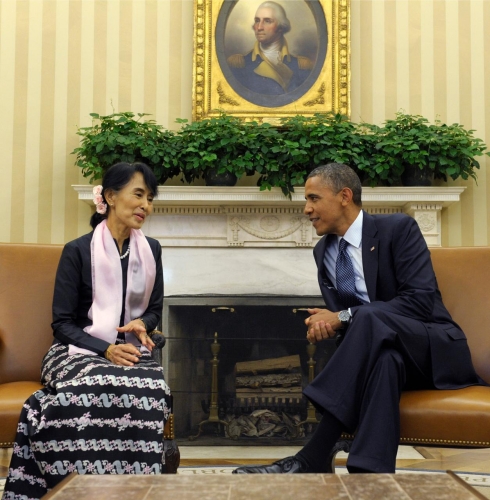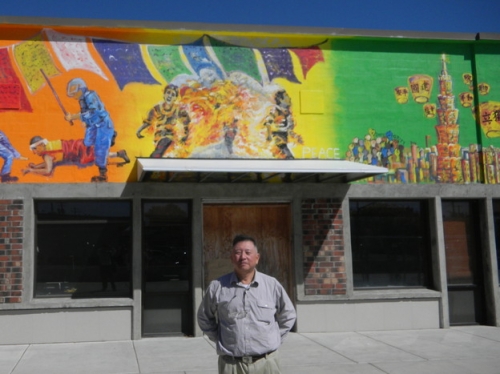
Here’s a fun fact: the Tricycle offices in New York are in the same building as a club owned by the rapper Jay-Z. Usually, it doesn’t mean much. No one is at work at 3 am on a Friday, which is presumably when the club is—excuse me for using this word—hoppin’. But this Monday Jay-Z and his wife Beyonce hosted a fundraiser for President Obama in the club, and the Tricycle staff were sent home early by what we presume were the Secret Service’s orders. Because nothing is more threatening to the President’s safety than a bunch of Buddhists typing furiously on their computers.
Though the Tricycle staff missed him, the Prez did manage to meet with another Buddhist this week: Aung San Suu Kyi, the Burmese democracy champion recently released from house arrest. Suu Kyi was presented with a Congressional Gold Medal as Hillary Clinton related her own trip to Burma last year. Apparently the speaker of the lower house of parliament in Burma told Hillary that they were trying to teach themselves to be a democratic congress by watching old episodes of the TV show The West Wing. (I’m not making that up—Reuters reported it.) Then Suu Kyi schmoozed with Obama as George Washington looked on, as you can see at right.
In some lower-scale American political news, the mayor of Corvallis, Oregon, is facing down Chinese consulate officials who are demanding that a mural depicting the human rights situation in Tibet be taken down. The mural, commissioned by Taiwanese businessman David Lin, stretches ten feet across his office building and shows self-immolators as well as Chinese police officers beating Tibetan monks. The Chinese sent a strongly worded letter to Corvallis’ mayor, Julie Manning, saying that the mural was offensive to Chinese students at Oregon State University. Manning sent them a strongly worded letter back, noting that the mural was protected under the First Amendment of the Constitution (the not-so-subtle message behind that being, “we’re not in China, buddy”). So for now, the mural stays up. Usually I’m not one to get all warm and fuzzy about patriotism, but this story did get me feeling a little proud of the United States. Right on, Lin and Manning!

And last, here’s a piece of news that will excite any Tricycle readers/movie buffs out there. Who remembers Baraka, the cult classic from the early 90s? The whole movie was a string of images from around the world with no dialogue, narrative, or plot. It was awesome; a meditation of sorts on what you never knew was happening on your planet. The filmmakers behind Baraka, Ron Fricke and Mark Magidson, are back with a new movie called Samsara. The basic premise is the same: all images, no words, total awesomeness. It was filmed over a period of five years in 25 different countries.
I had the pleasure of seeing Samsara a few months ago and I’m happy to report that the actual film does live up to the epic-ness of that trailer.
Fricke and Magidson were interviewed this week on the Huffington Post. I think they are closet Buddhists, no matter how they answered the last question:
For viewers that haven’t yet heard of Samsara, can you sum up what the film is about?
Ron: We envisioned and created Samsara as a non-verbal, guided meditation on the themes of birth, death and rebirth. It’s a follow up film on Baraka and we’re dealing with the same overall theme of interconnection that Baraka dealt with and humanity’s relationship to the eternal. Samsara takes these concepts to a different level. The Buddhist Sanskrit word Samsara is really about the wheel of life or impermanence: the flow of life and how we’re all connected to that flow.
The film moves the viewer between elating and disturbing scenes. What were the most emotionally challenging places for you to film?
Ron: There was a location that had us down on the ground, blind and gagging. We couldn’t breathe. It was when we were filming the sulfur miners at the volcano. That vapor you saw in the background was sulfuric acid and when the wind changed it just knocked us out. But you know, I think it’s all emotionally challenging. You see a lot of conditions out there you wouldn’t want to be working in or involved in. But it’s all part of what we were showing: how we’re all interconnected, no matter who you are, where we are or what we’re doing.
Both films are very spiritual portrayals of the world. Would you consider yourself formally religious? If not, what are your guiding life principles?
Ron: My frame of reference is that we are all spiritual beings, always have been, always will be whether you know it or not.
Mark: You don’t go out and spend five years making a 90-minute movie like this unless you just really feel a desire to show that interconnectedness that we all share. I don’t know if you could call it an organized religious stance, it’s just an individual thing.
A review of Samsara is going to appear in the Winter 2012 edition of Tricycle, so keep an eye out!